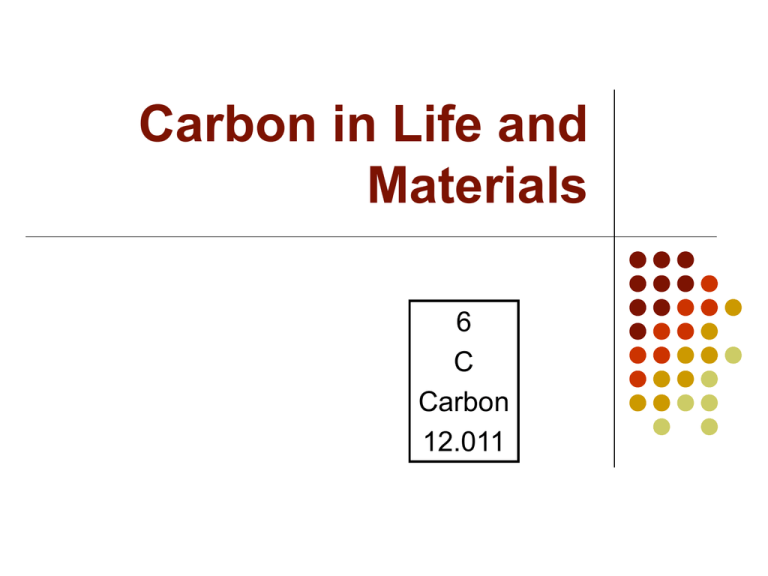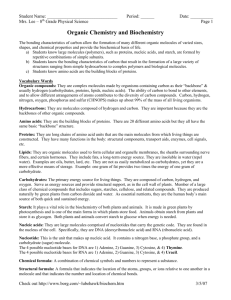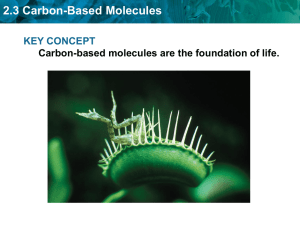Carbon in Life and Materials
advertisement

Carbon in Life and Materials 6 C Carbon 12.011 Organic Compounds Organic Compounds: Contain carbon-hydrogen bonds Often contain N, S, P Major types: carbohydrates, proteins, lipids, and nucleic acids. Are not just living things but can also be made in a lab…example: sugar www.organicsbydesign.com www.hermann-uwe.de Inorganic Compounds Inorganic Compounds: Substances that do not have carbon-hydrogen bonds Not normally found in living things Examples minerals, metals, and salts universoulproductions.wordpress.com Exceptions to the rule: (all inorganic) Diamonds (C), graphite (C), carbon dioxide (CO2) www.ndt-ed.org Carbon forms many different compounds Large variety of compounds results from the number of bonds that each carbon atom can form Carbon atoms always share four pairs of electrons in four covalent bonds Single bond Double bond Triple bond Carbon-based molecules can have many structures nafaa.pbwiki.com Chains Carbon atoms can bond together to form chains that are straight or branched Rings Carbon rings contain at least 5 carbon atoms www.green-planet-solar-energy.com Isomers Isomer: compounds that contain the same atoms, but in different places Both have 4 Carbons and 10 Hydrogens Butane Isobutane cornellbiochem.wikispaces.com Carbon-based molecules are life’s building blocks www.rbge.org.uk Carbon-based molecules have many functions in living things Similarities All contain carbon and hydrogen or oxygen, nitrogen, sulfur, phosphorus. Large molecules www.ucmp.berkeley.edu Life’s Carbon-based molecules Carbohydrates Lipids Proteins Nucleic acids mrscraigsbiology.blogspot.com Carbohydrates Carbohydrate: contain carbon, hydrogen, and oxygen…examples: sugars, starches, and cellulose. Sugar: glucose C6H12O6 Cells in both plants and animals break down glucose for energy Starch: many glucose molecules When starch is broken down many glucose molecules are broken down and used for energy Cellulose: plant cell walls Carbohydrate that is composed of glucose Lipids Lipid: fats and oils that are used for energy and as structural materials in living things Fat…saturated and unsaturated Made up of carbon, hydrogen, and oxygen Structure different from carbohydrates Animals store chemical energy in fat Saturated: all the bonds in the lipid are single, most animal fats…too much saturated fat could lead to heart disease Unsaturated: one or more bonds in lipid are double Cholesterol lipid that is part of cell membranes Makes hormones (chemical messengers in your body) Proteins Proteins: macromolecules (large) that are made up of amino acids Contain carbon, hydrogen, oxygen, nitrogen, sulfur, and other elements Many different functions Function based on order of amino acids 20 different amino acids make up the proteins in your body Function is based on structure Nucleic Acids Nucleic acids: huge, complex carbon-based molecules that contain information that cells use to make proteins Made of carbon, hydrogen, oxygen, nitrogen, and phosphorus Each cell in your body contains a complete set of nucleic acids…so each cell has all of the instructions it needs to make the proteins your body needs DNA Deoxyribonucleic Acid …nucleic acid that contains the genetic code Sides of ladder made of sugar and phosphate Rungs (steps) are made up of cytosine (C), guanine (G), adenine (A), Thymine (T). C and G always pair A and T always pair eapbiofield.wikispaces.com Carbon-based molecules Carbohydrates Lipids Proteins Nucleic Acids Sugars Include Function DNA depends on order of amino acids Structure, transport, immune system, enzymes Carries and starches fats and Energy for cells oils Energy Plant cell walls for cells Cell membran es genetic code Sequence of three DNA bases is the code for an amino acid Carbon Cycle eo.ucar.edu Carbon-based molecules in many materials Hydrocarbon: a compound made of hydrogen and carbon Found in large deposits (petroleum) Polymers Very large carbon-based molecules made of smaller repeating units (monomers) Formation by chemical reactions that bond monomers together Plastics (polypropylene)…capable of being molded or shaped…plastics can be recycled








